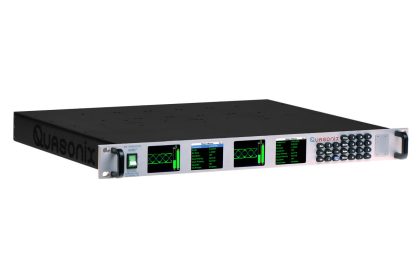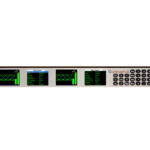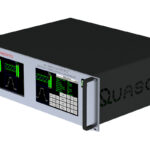
The Final Word on Data Integrity
The highest performing telemetry receiver on the market is available in an elegant, compact 1U rack mount package and a 3U touchscreen package with dual, 7-inch full color touchscreens. Configurations include one channel, two channels, or two channels plus combiner; an integrated three-channel spectrum analyzer; automatic AGC zeroing; PCM deframing (header detection/extraction, Sub-Frame ID (SFID) checking/extraction); built-in playback demodulator; combiner IF output; simultaneous TTL and RS-422 outputs; contiguous frequency tuning; adaptive equalizer; and decoding for SOQPSK Space Time Coded and Low Density Parity Check encoded signals.
Features
Options
Accessories
Operation
Key Features
- Complete Receiver – RF to Bits – a single-box solution that includes downconversion, demodulation, and bit synchronization
- Data Quality Encapsulation (DQE) to bundle Data Quality Metric (DQM) words with payload data, including a sync word to aid BSS time alignment; built-in real-time DQM display
- Best-Channel Selector (BCS) seamlessly selects the best channel (Channel 1, Channel 2, or Pre-Detection Diversity Combiner) based on DQM, which is then used as the combiner data output
- Built-in integrated three-channel spectrum analyzer shows frequency domain view for up to three channels simultaneously
- Multi-Mode diversity combiner supports both Maximal Ratio Combining and Best Source Selection modes and features a revolutionary dynamic time alignment function that increases the allowable time skew between channels by over 1300 nanoseconds—more than 60 bits at high bit rates!
- Built-in playback demodulator IF inputs for each channel, 75 kHz to 20 MHz, or 70 MHz with selectable SAW filter
- Simultaneous RS-422 and TTL for all units
- NEW IRIG 218-20 compatible telemetry transport (TMoIP) via 1000 Base-T Gigabit Ethernet RJ45 port (requires -IP2 option)
- Tuning Range from 200 MHz to 5250 MHz
- Versatile Rack-Mount Enclosures – 1U or 3U 19” rack-mount chassis houses one or two receiver channels covering P, lower L, upper L, full S, C, or multiple bands per channel
- Easy on-site updates of software and firmware may now be installed by the customer on-site via SD card or network
- Best SOQPSK-TG detection in the Industry, yielding improvements of 2 dB or more over the competition’s single-symbol detectors
- True multi-symbol trellis detection all three ARTM modes for optimal demodulation
- 3.5 to 5 dB improvement in PCM/FM performance vs. the best single-symbol demodulators, to within 0.2 dB of the theoretical limit
- Enhanced Modulation Index Tracking* for PCM/FM maintains superior BER performance even if the received signal’s modulation index varies by as much as 500%, a major breakthrough for tracking legacy analog transmitters (*patented)
- Phase Noise Compensation optimizes demodulator performance for use with legacy TM packs and transmitters with excessive phase noise
- Typical noise figure of 3.5 dB bests all other ARTM receivers on the market, hands down
- Synchronizes up to 100 times faster – and maintains sync at lower signal-to-noise ratios – than any other ARTM demodulator
- Spectrum analyzer shows frequency domain view for up to three channels simultaneously
- Automatic AGC zeroing
- Browser-based remote interface
Product Literature
| Type | Title | Version | File Size | Updated | Length | Description |
|---|---|---|---|---|---|---|
| RDMS™ Rackmount Receiver Datasheet (Gen 3) | 2024.10.08 | Features, specifications, and options of the Gen 3 Rackmount RDMS™ Telemetry Receiver. | |||
| Quasonix Catalog | 2024.10.25 | Catalog of Quasonix’s full product line including transmitters, antennas, receivers, networking equipment, and test equipment. Also includes examples of possible product configurations. | |||
| Data Quality Magic | 2021.04.21 | QUASONIX CONNECTION April, 2021 Topics: – Data Quality Magic – A Better Two-Antenna Solution – SAVE on our Latest RDMS™ Features | |||
| Status Logger Steps it Up | 2021.11.21 | QUASONIX CONNECTION November, 2021 Topics: – Status Logger Steps it Up – RDMS™ Release 19.2 Now Available | |||
| Best-Channel Selection Field Test Results ITC Paper | 2019.10.21 | “Dual-Channel Receiver Performance Using Best-Channel Selection: Field Test Results,” by Jim Uetrecht; presented at ITC 2019. | |||
| Best-Channel Selection ITC Paper | 2018.11.05 | “Obtaining Superior Performance From Dual-Channel Receivers Using Best-Channel Selection,” by Jim Uetrecht; presented at ITC 2018. | |||
| RDMS™ Rackmount Receiver Comparison (Gen 2 vs Gen 3) | 2015.06.29 | Feature comparison of Gen 2 and Gen 3 rackmount RDMS™ Receivers, showing the advancements of Gen 3 and enhancements available in the 3U model. | |||
| RDMS™ Rackmount Reciever Standard Letter of Volatility (Gen 3) | 2015.04.30 | This document describes the memory and media present in Quasonix RDMS™ third-generation receivers and notes that payload data cannot be stored in the RDMS™ itself, nor can it be routed to other devices on its Ethernet network. | |||
| RDMS™ Rackmount Reciever Standard Letter of Volatility (Gen 2) | 2013.05.06 | This document describes the memory and media present in Quasonix RDMS™ second-generation receivers. |
Available Options
- IP packet output of PCM data (TMoIP, IAW IRIG-218)
- Ethernet payload, used for Ethernet Via Telemetry (EVTM)
- Powerful adaptive equalizer mitigates multipath distortion
- Optional contiguous tuning from 200 MHz through 2500 MHz and 4400 MHz through 5250 MHz
- Low Density Parity Check coding, included in all receivers with SOQPSK demodulation, operates with Quasonix LDPC-enabled transmitters to improve link margin by up to 9 dB, while still using 22% less bandwidth than PCM/FM at the same payload data rate
- Space-Time Coding (STC), included in all rackmount receivers with SOQPSK demodulation, operates with Quasonix STC-enabled transmitters to eliminate the dropouts caused by transmit antenna pattern nulls due to inter-antenna interference
- Viterbi decoder (k=7, R=1/2), Tier 0, Legacy
- SAW IF filters (14)
- Cyber-security features
Option Literature
| Type | Title | Version | File Size | Updated | Length | Description |
|---|---|---|---|---|---|---|
| Receiver and Transmitter Low-Density Parity Check Datasheet | 2024.10.08 | The Low Density Parity Check (LDPC) Forward Error Correction mode improves link margin equivalent to nearly tripling the operating distance on your telemetry link. | |||
| Receiver and Transmitter Space-Time Coding Datasheet | 2024.10.08 | The Quasonix Space Time Coding Solution eliminates link outages caused by the “two-antenna problem,” improving behavior of received signal power and overall link availability. | |||
| RDMS™ Receiver Adaptive Equalizer Datasheet | 2022.11.16 | Describes Quasonix’s telemetry receivers’ Adaptive Equalizer Mode, which combats multipath fading. | |||
| RDMS™ Adaptive Equalizer Demonstration – PCMFM | 2022.12.15 | 2:03 | Brief demonstration of our RDMS™ Adaptive Equalizer conquering severe multipath distortion (PCMFM signal). (Used in TM Smorgasbord training, Day 2.) | ||
| RDMS™ Adaptive Equalizer Demonstration – SOQPSK | 2022.12.16 | 1:33 | Brief demonstration of our RDMS™ Adaptive Equalizer conquering severe multipath distortion (SOQPSK signal). | ||
| Space-Time Coding ITC Paper | 2014.10.20 | “Space-Time Coding Solution to the Two-Antenna Interference Problem,” by Mark Geoghegan & Louis Boucher; presented at ITC 2014. | |||
| SOQPSK with LDPC ITC Paper | 2013.10.21 | “SOQPSK with LDPC: Spending Bandwidth to Buy Link Margin,” by Terry Hill & Jim Uetrecht; presented at ITC 2013. |
Accessories
| Image | Item | Description |
|---|
Accessory Literature
| Type | Title | Version | File Size | Updated | Length | Description |
|---|
User Manuals and Guides
| Type | Title | Version | File Size | Updated | Length | Description |
|---|---|---|---|---|---|---|
| RDMS™ Rackmount Receiver Manual (Gen 3, R19) | 3.8.2 | 2025.05.16 | Installation and operation of the Quasonix 3rd Generation Rackmount RDMS™ Telemetry Receiver, updated to match RDMS™ System Version 19.3. | ||
| Receiver and Transmitter Low-Density Parity Check Guide | 1.1.1 | 2024.01.26 | This technical guide introduces Low-Density Parity Check (LDPC) encoding, its uses and benefits, the Quasonix products it is available for, and considerations for optimal set-up and use. | ||
| RDMS™ Receiver Scripting Guide | 1.0 | 2023.01.25 | Technical guide for understanding, creating, and editing scripts for Quasonix RDMS™ receivers. | ||
| RDMS™ Receiver Bit Error Rate Testing Guide | 1.0.1 | 2022.04.24 | Instructions and commands for bit error rate testing on Quasonix RDMS™ receivers, plus guidance on using test noise (AWGN) commands. | ||
| RDMS™ Receiver Telnet and Serial Control Protocol Guide | 1.0.5 | 2022.12.12 | Instructions for accessing and using Quasonix RDMS™ receivers’ serial control interface, including commands and syntax, for debugging purposes. The Telnet interface should only be accessed by advanced users. Contact Quasonix customer support before using these options. | ||
| RDMS™ Rackmount Receiver Firmware Update Guide (Gen 3) | 1.2 | 2021.11.01 | Documents three methods for updating firmware on a Quasonix 3rd-Generation Rackmount RDMS™ Telemetry Receiver: SD Card; Network ; and Local. | ||
| DQM and RDMS™ Troubleshooting Guide | 2021.03.28 | Introduction to the Data Quality Metric and its role in troubleshooting, and an essential troubleshooting flowchart for Gen 3 RDMS™. | |||
| RDMS™ Rackmount Receiver Manual (Gen 3, R18) | 3.6 | 2020.11.10 | Installation and operation of the Quasonix 3rd Generation Rackmount RDMS™ Telemetry Receiver, updated to match RDMS™ System Version 18. | ||
| RDMS™ Rackmount Receiver Manual (Gen 3, R16) | 3.4.8 | 2019.08.05 | Installation and operation of the Quasonix 3rd Generation Rack-Mount RDMS™ Telemetry Receiver, updated to match RDMS™ System Version 16. | ||
| RDMS™ Rackmount Receiver Manual (Gen 3, R17) | 3.5.2 | 2019.10.17 | Installation and operation of the Quasonix 3rd Generation Rack-Mount RDMS™ Telemetry Receiver, updated to match RDMS™ System Version 17. | ||
| RDMS™ Rackmount Receiver Tape Output Configuration Guide | 1.1.1 | 2018.07.23 | How to set up tape output for third-generation Quasonix rackmount telemetry receivers, including commands, connectors used, and troubleshooting. | ||
| RDMS™ Rackmount Receiver Manual (Gen 3, R15) | 3.2 | 2018.06.12 | Installation and operation of the Quasonix 3rd Generation Rack-Mount RDMS™ Telemetry Receiver, matching RDMS™ System Version 15. | ||
| RDMS™ Rackmount Receiver Manual (Gen 3, R14) | 3.0.5 | 2018.02.10 | Installation and operation of the Quasonix 3rd Generation Rack-Mount RDMS™ Telemetry Receiver, matching RDMS™ System Version 14. | ||
| RDMS™ Rackmount Receiver Manual (Gen 3, R12 / R13) | 2.8.3 | 2017.09.07 | Installation and operation of the Quasonix 3rd Generation Rack-Mount RDMS™ Telemetry Receiver, matching RDMS™ System Versions 12 and 13. | ||
| RDMS™ Rackmount Receiver Manual (Gen 3, R11) | 2.6.3 | 2016.12.23 | Installation and operation of the Quasonix 3rd Generation Rack-Mount RDMS™ Telemetry Receiver, matching RDMS™ System Version 11. | ||
| RDMS™ Rackmount Receiver Manual (Gen 3, R9 / R10) | 2.5.8 | 2016.10.25 | Installation and operation of the Quasonix 3rd Generation Rack-Mount RDMS™ Telemetry Receiver, matching RDMS™ System Versions 9 and 10. | ||
| Phase Noise Compensation Training | 2015.06.11 | Presents the theory of using the phase tree for data detection to improve bit error rate (BER), how to recognize phase noise, and when to use Phase Noise Correction (PNC). |
Software Downloads
| Type | Title | Version | File Size | Updated | Length | Description |
|---|










